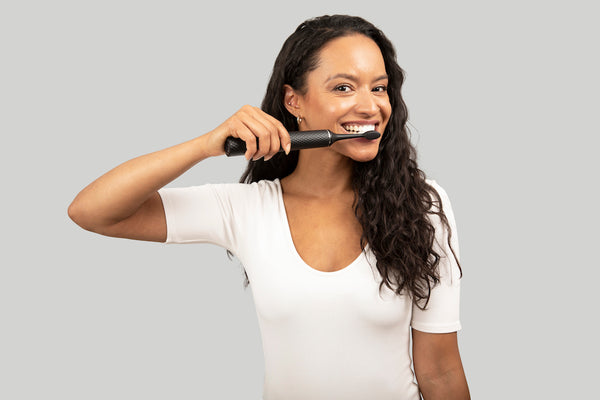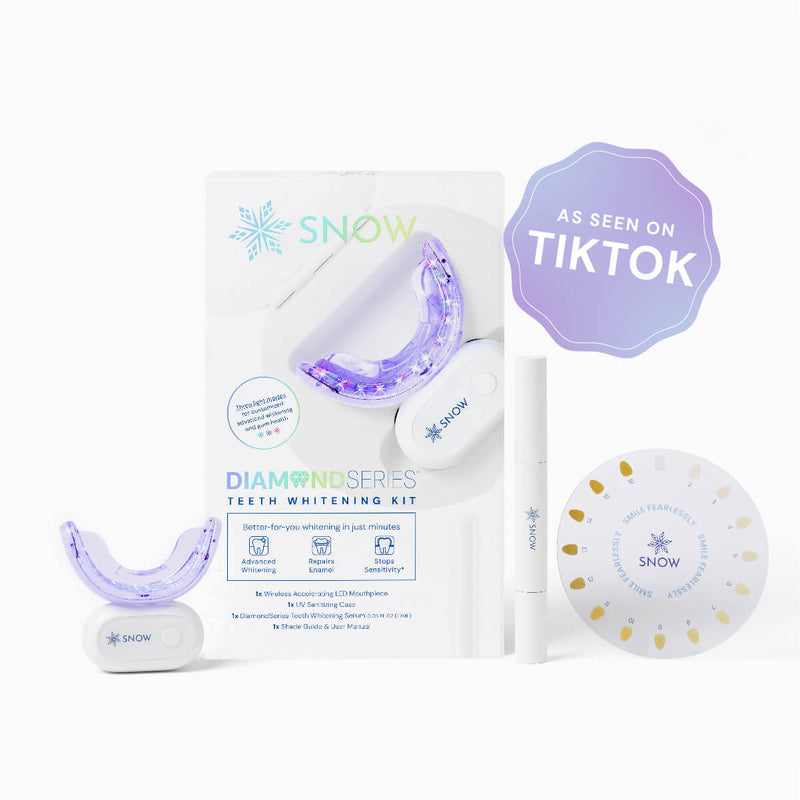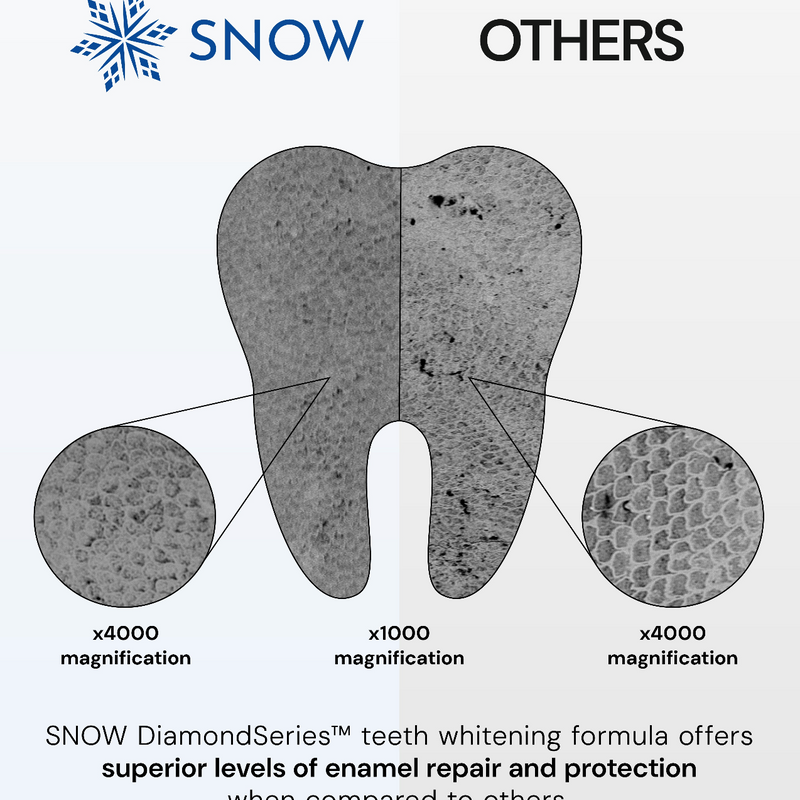At SNOW, we understand the importance of dental hygiene, especially after illness. Knowing when to change toothbrush after being sick is more straightforward than you might think.
For the record, we recommend that you replace your toothbrush post-illness to maintain optimal oral health.
In this article, we'll delve into the reasons behind this recommendation, exploring topics such as the persistence of germs on toothbrushes, the potential for reinfection, and the best practices for toothbrush care.
Additionally, we'll provide expert insights on how to disinfect your toothbrush and address common FAQs surrounding this topic.
Stay tuned to learn how prioritizing your dental hygiene, including timely toothbrush replacement, can contribute to a healthier smile.
What this article covers:- Do Germs Stay on Your Toothbrush?
- Should You Change Your Toothbrush After Having a Cold or Flu?
- Can You Get Sick From Your Toothbrush?
- When Should You Replace Your Toothbrush?
- How Should You Care for Your Toothbrush?
- Should You Disinfect Your Toothbrush After You've Been Sick?
- What Happens If You Don't Change Your Toothbrush After Being Sick?
- ADA Recommendations for Keeping Toothbrush as Germ-Free as Possible
- Replacing Toothbrush After Being Sick FAQs
Do Germs Stay on Your Toothbrush?
Yes, germs can indeed linger on your toothbrush after an illness. Bacteria from your mouth and the illness can remain on the bristles, potentially causing reinfection or spreading to others.
To ensure a clean toothbrush, it's advisable to disinfect it regularly and let it dry properly after each use.
According to a study published in the National Center for Biotechnology Information, toothbrushes can harbor various microorganisms, including bacteria and viruses, even after rinsing with water.

These pathogens can survive on the toothbrush surface for extended periods, increasing the risk of recurrent infections. Therefore, it's crucial to maintain proper toothbrush hygiene practices to minimize the transmission of germs.
Regularly replacing toothbrushes, disinfecting them after illness, and storing them in a dry area can help reduce the accumulation of harmful microorganisms.
By prioritizing dental hygiene, including effective toothbrush care, individuals can promote overall oral health and prevent the spread of infectious diseases.
Should You Change Your Toothbrush After Having a Cold or Flu?
Yes, it's essential to change your toothbrush after recovering from a cold or flu. Lingering bacteria on the bristles can potentially cause reinfection or prolong the illness.
At SNOW, we prioritize dental hygiene, especially after illness, to prevent the spread of germs and maintain optimal oral health.
For effective at-home teeth whitening and overall oral care, SNOW offers innovative electric toothbrushes.
Our LED Teeth Whitening Electric Toothbrush and Advanced Whitening Electric Toothbrush are designed to gently yet effectively remove surface stains while promoting gum health.
With advanced features and ergonomic designs, our electric toothbrushes ensure a thorough cleaning experience for a brighter, healthier smile.
Can You Get Sick From Your Toothbrush?
Yes, it's possible to get sick from a contaminated toothbrush, although it's relatively uncommon.
If your toothbrush harbors harmful bacteria, it can lead to illness when those bacteria come into contact with your mouth during brushing.
SNOW emphasizes the importance of proper toothbrush hygiene to reduce the risk of contamination and illness.
When it comes to cleaning electric toothbrushes, ensure that all removable parts are detached and cleaned separately to eliminate any bacteria or virus particles effectively.

Can Your Toothbrush Make Others Sick?
Absolutely. If your toothbrush carries contagious bacteria, it has the potential to transmit illness to others.
When storing toothbrushes in shared spaces or traveling with them, it's crucial to take measures to prevent cross-contamination and the spread of germs.
SNOW encourages individuals to store their toothbrushes in a clean, dry area and avoid sharing them to minimize the risk of spreading illness.
When Should You Replace Your Toothbrush?
SNOW recommends replacing your toothbrush every three to four months to maintain optimal oral hygiene.
This regular replacement schedule helps ensure effective plaque removal and prevents bacterial buildup on the bristles.
Additionally, if you've been sick, it's advisable to replace your toothbrush promptly to minimize the risk of reinfection or spreading illness.
By adhering to these guidelines, you can maintain a clean and healthy mouth, promoting overall well-being.
Furthermore, understanding how electric toothbrushes work can significantly improve your oral hygiene routine by ensuring you are using the device correctly and efficiently.

How Should You Care for Your Toothbrush?
To ensure the longevity and effectiveness of your toothbrush, SNOW recommends following these steps:
- Rinse thoroughly: After each use, thoroughly rinse your toothbrush under running water to remove any remaining toothpaste and debris. This helps prevent the buildup of bacteria on the bristles.
- Store upright: According to WikiHow, storing your toothbrush in an upright position will allow it to air dry between uses. Avoid covering the brush head or storing it in closed containers, as this can promote bacterial growth. Instead, place it in a holder where it can air out freely.
- Replace regularly: As mentioned earlier, replace your toothbrush or toothbrush head every three to four months or sooner if the bristles become frayed or worn out. This ensures that you're using a clean and effective toothbrush for optimal oral hygiene.
By following these simple steps, you can maintain a clean and hygienic toothbrush, promoting better oral health and maximizing the effectiveness of your at-home teeth whitening routine.
Should You Disinfect Your Toothbrush After You've Been Sick?
While not always essential, SNOW recommends considering disinfecting your toothbrush after being sick to ensure optimal oral hygiene. Here's a simple method to do so:
- Soaking in mouthwash or hydrogen peroxide: Submerge the bristles of your toothbrush in antibacterial mouthwash or a hydrogen peroxide solution for a few minutes. This can help kill any remaining bacteria on the brush.
- Rinsing thoroughly: After soaking, thoroughly rinse your toothbrush under running water to remove any residual mouthwash or hydrogen peroxide.
By following these steps, you can take proactive measures to minimize the risk of reinfection and maintain good oral health, especially after recovering from an illness.
What Happens If You Don't Change Your Toothbrush After Being Sick?
Not replacing your toothbrush after being sick poses risks to your oral health. Here's why:
- Bacteria buildup: Harmful bacteria from your illness can linger on the toothbrush bristles, increasing the risk of reinfection or spreading the illness to others.
- Potential reinfection: Reusing a contaminated toothbrush can reintroduce the same pathogens into your mouth, prolonging or reigniting the illness.
- Oral health issues: The buildup of bacteria on the toothbrush can contribute to oral health problems such as cavities, gum disease, and bad breath.
By neglecting to change your toothbrush after being sick, you may compromise your oral hygiene and increase the likelihood of illness recurrence or other dental issues.

ADA Recommendations For Keeping Toothbrush As Germ-Free As Possible
Following the American Dental Association (ADA) guidelines ensures optimal oral hygiene. Here's how SNOW recommends keeping your toothbrush germ-free:
- Regular replacement: SNOW advises changing your toothbrush every three to four months and after illnesses. This practice helps prevent bacterial buildup and maintains effective brushing.
- Avoid sharing: Never share your toothbrush or toothpaste to prevent the transfer of germs and bacteria.
- Rinse and air dry: After each use, thoroughly rinse your toothbrush with water to remove debris and toothpaste residue. Allow it to air dry in an upright position to discourage bacterial growth.
- Avoid covering: Avoid covering your toothbrush, as this creates a moist environment that promotes bacterial proliferation. Opt for open-air storage to keep your toothbrush dry and sanitary.
By following these recommendations, you can maintain a germ-free toothbrush and promote better oral health.
Replacing Toothbrush After Being Sick FAQs
Should you replace your toothbrush after a cold sore?
Yes, it's advisable to replace your toothbrush after a cold sore to prevent reinfection.
Should you change your toothbrush after recovering from COVID-19?
Yes, it's recommended to replace your toothbrush after recovering from COVID-19 to minimize the risk of reinfection.
Should you change your toothbrush after getting strep throat?
Yes, it's prudent to replace your toothbrush after having strep throat to prevent the spread of bacteria.
Can you sanitize a toothbrush after being sick?
Yes, you can sanitize a toothbrush by soaking it in an antibacterial solution or boiling it in water for a few minutes.
Can you reinfect yourself with a cold by using the same toothbrush?
While rare, it's possible to reinfect yourself with a cold by using a contaminated toothbrush, especially if it's not replaced after being sick.
Should you get a new toothbrush after being sick?
Yes, it's recommended to get a new toothbrush after being sick to maintain optimal oral hygiene and prevent reinfection.

Conclusion
Ensuring proper toothbrush hygiene is crucial for maintaining oral health. From the ADA's recommendations to practical tips like rinsing and air-drying, SNOW emphasizes the importance of regular toothbrush replacement and cleanliness.
By following these guidelines and replacing toothbrushes every three to four months, individuals can reduce the risk of bacterial buildup and potential reinfection after illnesses.
Remember, avoid sharing toothbrushes, allow them to air dry, and refrain from covering them.
For a brighter smile, complement your oral care routine with SNOW's teeth whitening products.
Your smile deserves the best care!
If you want to learn more, why not check out these posts:
- Can Using an Old Toothbrush Make You Sick
- Cleaning Toothbrush with Vinegar
- Benefits of Electric Toothbrush
- How Often to Replace Electric Toothbrush
- Can Electric Toothbrushes Damage Teeth?
- Are Electric Toothbrushes Worth It?
- Mold in Electric Toothbrush
- Best Toothbrush for 4 Year Old
- Best Electric Toothbrush for Elderly
- Toothbrushes for Different Ages
- Best Manual Toothbrush for 8 Year Old
- Vibrating Toothbrush vs. Rotating
- Electric Toothbrush or Manual
- Bamboo Toothbrush Benefits
- Tongue Scraper vs. Toothbrush























